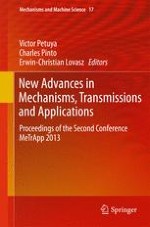The Second Conference on Mechanisms, Transmissions and Applications - MeTrApp 2013 was organised by the Mechanical Engineering Department of the University of the Basque Country (Spain) under the patronage of the IFToMM Technical Committees Linkages and Mechanical Controls and Micromachines and the Spanish Association of Mechanical Engineering.
The aim of the workshop was to bring together researchers, scientists, industry experts and students to provide, in a friendly and stimulating environment, the opportunity to exchange know-how and promote collaboration in the field of Mechanism and Machine Science.
The topics treated in this volume are mechanism and machine design, biomechanics, mechanical transmissions, mechatronics, computational and experimental methods, dynamics of mechanisms and micromechanisms and microactuators.
